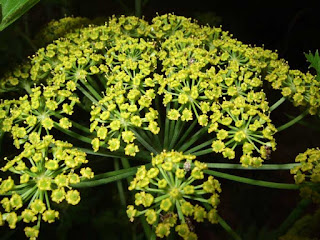After discussing wild carrots with a friend of mine (he seemed impressed to hear that they are quite easy to find, as you may too if you're hearing this for the first time), I decided tonight to write (with an emphasis on its flowering patterns) about the Apiaceae (or Umbelliferae) family, under which Wikipedia lists the well known plants: angelica, anise, arracacha, asafoetida, caraway, carrot, celery, Centella asiatica, chervil, cicely, coriander/cilantro, cumin, dill, fennel, hemlock, lovage, Queen Anne's lace, parsley, parsnip, sea holly, and the now extinct silphium.”
To help with the understanding of these plants, I’ll first
elaborate briefly on the two different names for this family:
The first, Apiaceae, comes from the root
Apis, which in Latin means "(of) bees", referring to its flowers which attract them
along with many other pollinators. Apium, a word of the same origin, is the Latin word for celery.
The second, Umbelliferae, in Latin again, meaning "bearing umbrellas", refers to the umbel-type flowering
pattern of these plants, which are actually several flowers supported on a
single head, of which there are two varieties:
Most plants in the family are of type b), called compound inflorescence, where a series of flowers meet together at a sub-node prior to attaching to the main steam, whereas in type a), each flower itself is directly connected to the main steam, called simple inflorescence. Within the type b) category, there are some flowers which, to the untrained eye (such as mine before today's research) can be wrongly interpreted as type a). Lets have a look with wild carrot (Daucus Carota):
Wild Carrot 1
Wild Carrot 1
At first guess, I'd think that all those short curving flower stems are each holding up their own individual flower. This is what type a), simple inflorescence, describes.
Wild Carrot 2

Upon further investigation... I notice tiny 5 petaled flowers growing together in clusters of about 8 or 9. These clusters must be growing from a sub-node. This is what type b), compound inflorescence, describes.
This flower is in fact, of type b). Not only is this the case for Wild Carrot, all its familiar cousins, including Anise, Angelica, Dill, Cumin, Fennel, Coriander, Parsley, Celery, Caraway, Chervil and Parsnip flowers also fall under this category.
Lets have a look.
Parsnip
Tiny yellow flowers easily seen meeting together first before leading down to the stem...
Dill
Cumin
Nice side view of the right-hand flower gone to seed.
This is perhaps the easiest time to notice the compound inflorescence pattern of several species in the family.
Poison Hemlock
Yikes! This one can kill you. It did just fine on Socrates.
Notice (for the last time, I promise!) again the individual tiny white flowers gathering in clusters before leading down to the main stem (not seen, beyond the bottom border of the image).
As you may have noticed, Poison Hemlock and Wild Carrot look sort of similar, with their white flowers forming these compound umbels... My intention was to help you notice their similarities, so that their differences which we shall see in my next post, will become more obvious.
Thanks for reading,
Jeff








No comments:
Post a Comment